Go-to-Market Strategy Examples
A company’s GTM strategy varies depending on its business plan, brand identity, resources, and products. These 10 examples of GTM strategies include inbound marketing, sales enablement, demand generation, and more. Each approach focuses on different sales and marketing channels or tactics.
Learn more about how to create an actionable GTM plan in our comprehensive guide to GTM strategy.
Inbound Go-to-Market Strategy
An inbound GTM strategy relies on marketing to engage potential customers and attract them to the product. Inbound marketing is often a foundational component of a company’s business plan and can be combined with other GTM strategies tailored to individual product launches. Key features of an inbound GTM strategy include content marketing, search engine optimization (SEO), lead generation, social media, and email marketing.
Since its founding in 2012, WorkCompOne has employed an inbound GTM strategy to acquire customers for its online workers’ compensation insurance platform. Its website hosts a variety of educational content to meet its audiences’ needs, including blog posts, in-depth guides, and state-specific compliance information. The blog is a key component of the company’s SEO strategy, targeting long-tail keywords to capture niche queries. WorkCompOne also incorporates vertical and industry-specific marketing strategies, tailoring content for different business sectors and geographic locations.

Taylor Radey, founder of Randall Pine, has worked with WorkCompOne to successfully implement its inbound GTM strategy. “A key differentiator for WorkCompOne's GTM strategy was taking a buyer-centric approach,” she says. “WorkCompOne recognized small businesses often search for workers’ comp based on location and state regulations. By targeting geo-specific keywords such as ‘California workers’ compensation insurance’ in its content and SEO efforts, WorkCompOne quickly became a leading source of relevant information for its target customer base.”
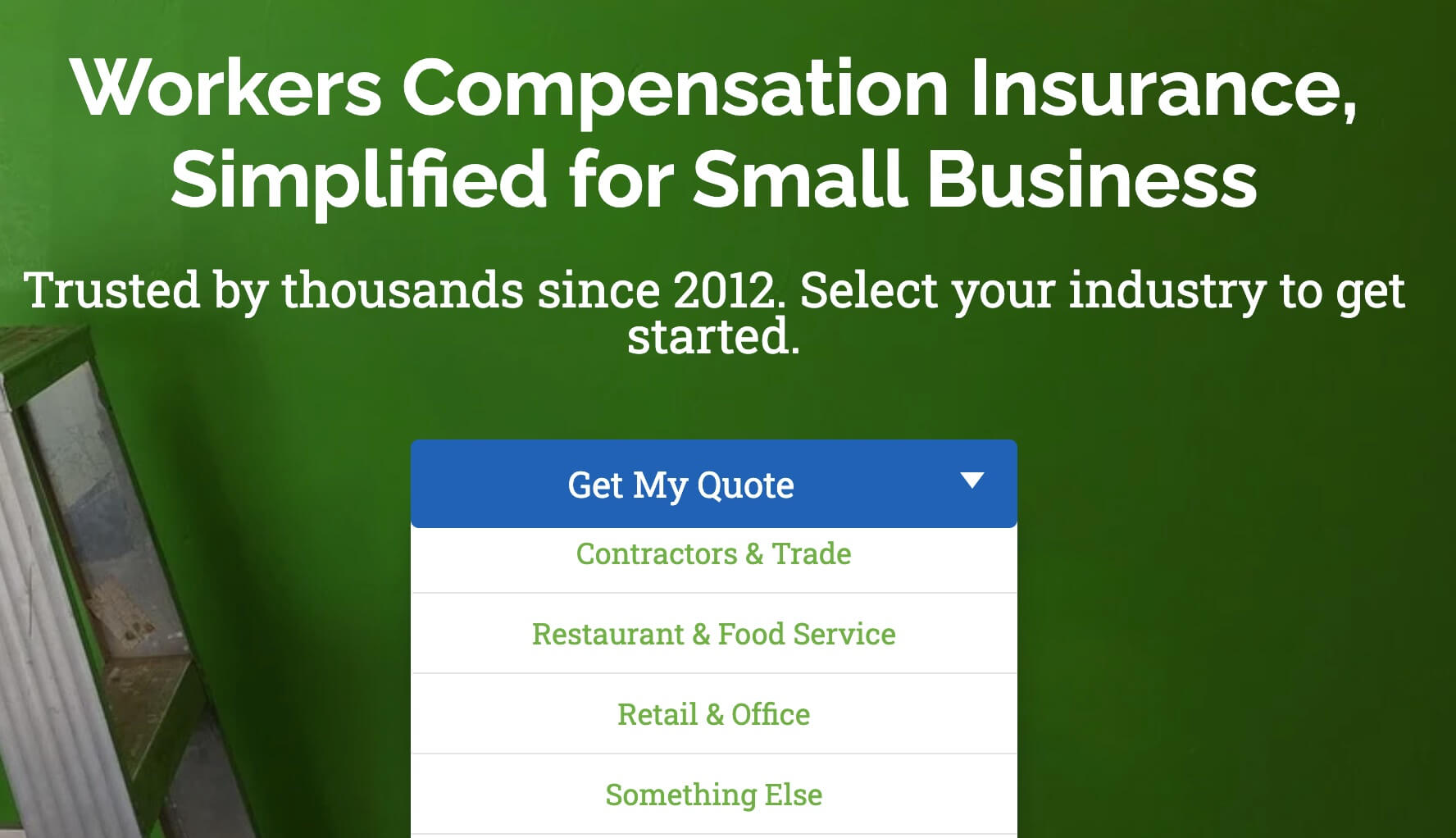
To effectively capture leads with its inbound strategy, WorkCompOne offers an easy-to-use quote form on its home page. Small business owners complete the form to receive customized quotes, providing WorkCompOne with essential information so it can offer customers accurate and tailored coverage. The company’s content-driven approach boasts impressive results. WorkCompOne has seen year-over-year growth in site traffic, with nearly 100 percent of traffic, leads, and sales generated through organic search.
“Content gives buyers confidence; content creates trust,” Radey concludes. “Many micro-business owners are buying workers’ compensation coverage for the first time. So we knew we needed plenty of content to win their trust and their business.”
Sales Enablement Go-to-Market Strategy
A sales enablement GTM strategy focuses on providing the sales team with the tools and resources needed to effectively drive conversions. Key elements of sales enablement plans include training the sales team on messaging and strategy, creating sales-related content such as catalogs or whitepapers, and implementing customer relationship management (CRM) software or other technology.
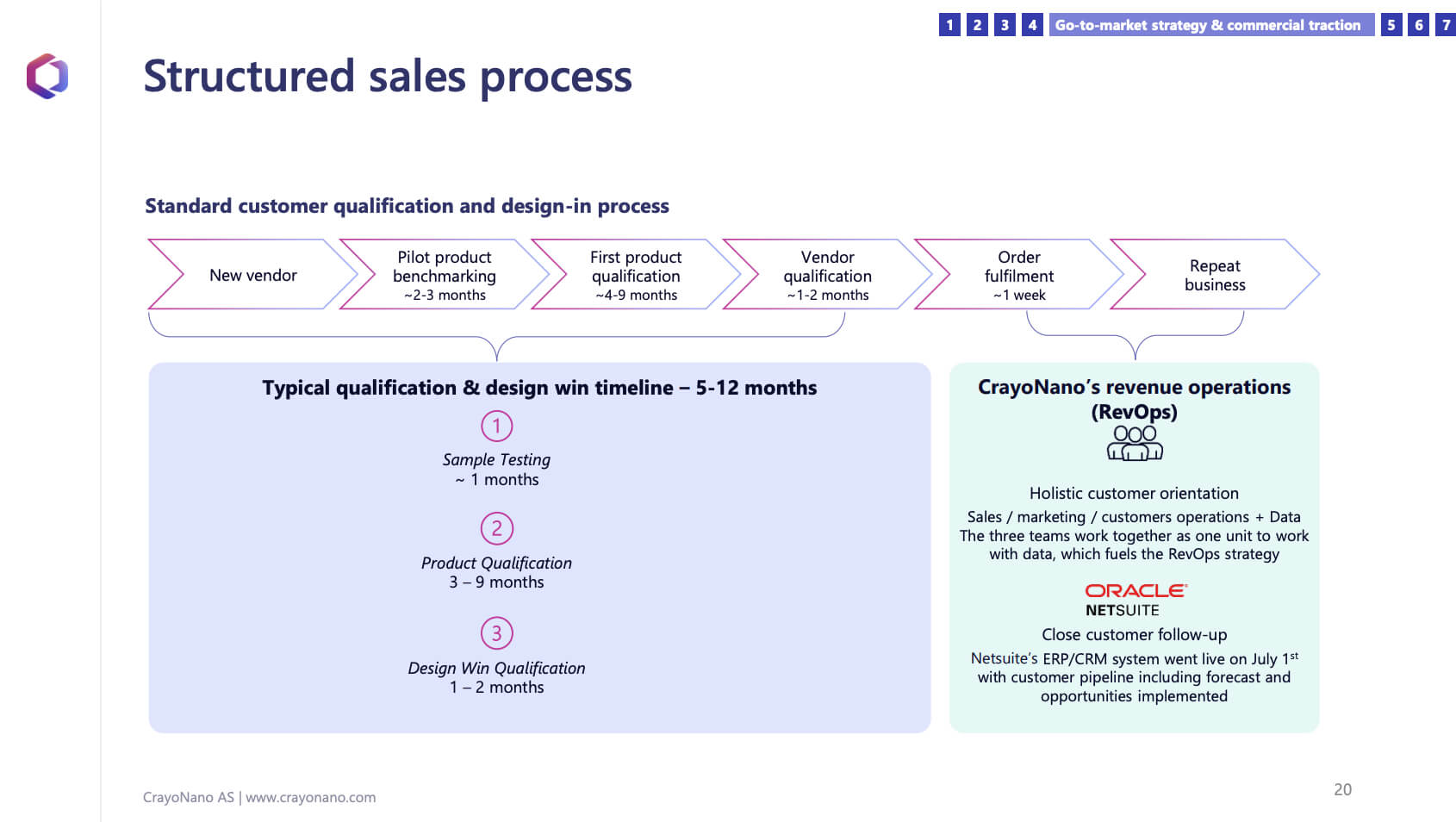
CrayoNano, a company that develops semiconductors, described its sales enablement GTM strategy in a 2023 presentation. The company provides its sales force with a CRM system that enables customer pipeline tracking. The GTM strategy also includes growing the sales team over time to ensure adequate personnel resources both internally and with international distribution partners.
Account-Based Marketing Go-to-Market Strategy
An account-based marketing (ABM) strategy involves developing marketing materials and sales outreach tailored to specific, high-value target customers. The first steps in an ABM GTM strategy are identifying key accounts and determining which marketing channels will reach them. These insights inform personalized marketing campaigns with unique value propositions tailored to each account. The sales strategy should align with the marketing efforts to deliver cohesive, consistent messaging to target customers. By concentrating resources on high-value accounts, ABM aims to build strong relationships, increase customer retention, and drive significant revenue growth.

Will Yang is the Head of Growth and Marketing at Instrumentl, a grant-management platform that helps organizations streamline their fundraising process. To reach its customer base of nonprofit and academic institutions, Instrumentl employs ABM as a crucial component of GTM strategy. “At Instrumentl, we utilized a blend of inbound marketing and ABM to grow our user base,” Yang says. “On the ABM side, we identify high-value nonprofit organizations that fit our ideal customer profile and create personalized campaigns to engage their decision-makers. This includes targeted emails, LinkedIn outreach, and personalized landing pages. The combined strategy ensures a steady stream of inbound leads while also securing large, key accounts that drive significant revenue growth.”
Demand Generation Go-to-Market Strategy
Demand generation is a GTM strategy that focuses on creating awareness and interest in a product or service. A demand generation GTM plan typically includes lead generation, webinars or events, content syndication, and pay-per-click (PPC) advertising. This approach aims to build a robust pipeline of potential customers by nurturing prospects through targeted content and engaging experiences. By integrating marketing tactics such as SEO, social media marketing, email campaigns, and influencer partnerships, businesses can effectively capture and convert leads into loyal customers.
Before joining the team at Instrumentl, Yang was the Chief Marketing Officer and Co-Founder at Albert, an edtech company. There, he employed a demand generation strategy with tactics including targeted ads and webinars to engage with the education community. “At Albert, our initial challenge was to penetrate the competitive edtech market with limited resources,” Yang says. “We implemented a combined demand generation and sales enablement strategy. First, we created high-value content that addressed educators' pain points and optimized SEO to drive organic traffic. This inbound approach nurtured leads through educational blog posts, webinars, and case studies.”
Following up on marketing qualified leads (MQLs) is crucial for demand generation strategies, which often means investing in the sales team. “For sales enablement, we developed tailored sales scripts and training materials for the growing sales team of 25,” Yang continues. “We integrated a CRM to track interactions and automate follow-ups. Our cohesive strategy from content production to sales outreach ramped up our annual recurring revenue (ARR) from $0 to multi-millions quickly.”
Product-Led Go-to-Market Strategy
A product-led GTM strategy relies on the features of the product itself as the primary driver of customer acquisition and retention. Sales typically take place within the product, with limited-time free trials, referral programs, or tiered freemium models to encourage conversions. Software-as-a-service (SaaS) companies often employ product-led strategies, particularly if the product is intuitive and its features serve as the main value proposition. These strategies may also include inbound marketing, lead-nurturing sequences, or other GTM tactics to complement the product-led growth.
Zoom employs a product-led GTM strategy based on its freemium model, which offers potential customers a free version that enables them to join and host meetings. Users learn about the features of Zoom Premium within the app and can upgrade at any time. The company continues to innovate and update its product offerings to respond to changes in the market and users’ needs.
In a 2023 annual report, Zoom described a growth strategy that begins with a seamless user experience. “Our platform is designed to make it easy to host meetings. By attracting free hosts to use our platform, we promote usage that allows hosts and their meeting attendees to experience the Zoom difference,” the report states, describing the product’s role in customer acquisition. “Our sales efforts funnel this viral demand into routes-to-market that are optimized for each customer opportunity, which can include our direct sales force, online channel, resellers, and strategic partners.”
Viral Go-to-Market Strategy
A viral GTM strategy focuses on mobilizing users to create growth through word-of-mouth and user-driven promotion. Similar to a product-led GTM strategy, it may rely on features of the product itself — e.g., integrated social media sharing buttons — to facilitate sharing and collaboration. Effective viral GTM strategies involve creating share-worthy content, encouraging user-generated content (UGC), and incentivizing users to share the product with their peers with referral bonuses or gamified rewards.
By tapping into existing user networks and fostering organic promotion, viral strategies can significantly amplify reach and accelerate customer acquisition at a relatively low cost. This approach is particularly effective for products with a strong social or collaborative component, where user satisfaction and engagement naturally lead to increased visibility and growth.

Sam Tarantino was a founder at the former music streaming service Grooveshark, which grew to 30 million monthly active users between 2006 and 2015. Tarantino, who now leads a fractional CMO practice called Harmonic Reach, credits the platform’s growth to its viral GTM strategy. “Our real success spike came through embedding social sharing features within the platform interface which encouraged users to share their playlists socially,” he says. “This created a viral loop, as each share exposed the platform to a new network of potential users, significantly echoing the reach and engagement without direct costs associated with user acquisition.”
Retail Go-to-Market Strategy
Going to market in a traditional retail environment involves specific strategies to successfully introduce and sell products in brick-and-mortar locations. This approach can complement other GTM strategies — e.g., an inbound strategy that bolsters brand awareness — or serve as the primary method for reaching customers. The GTM plan may include in-store promotions, staff training to promote optimal customer experience, loyalty programs, and competitive pricing strategies.
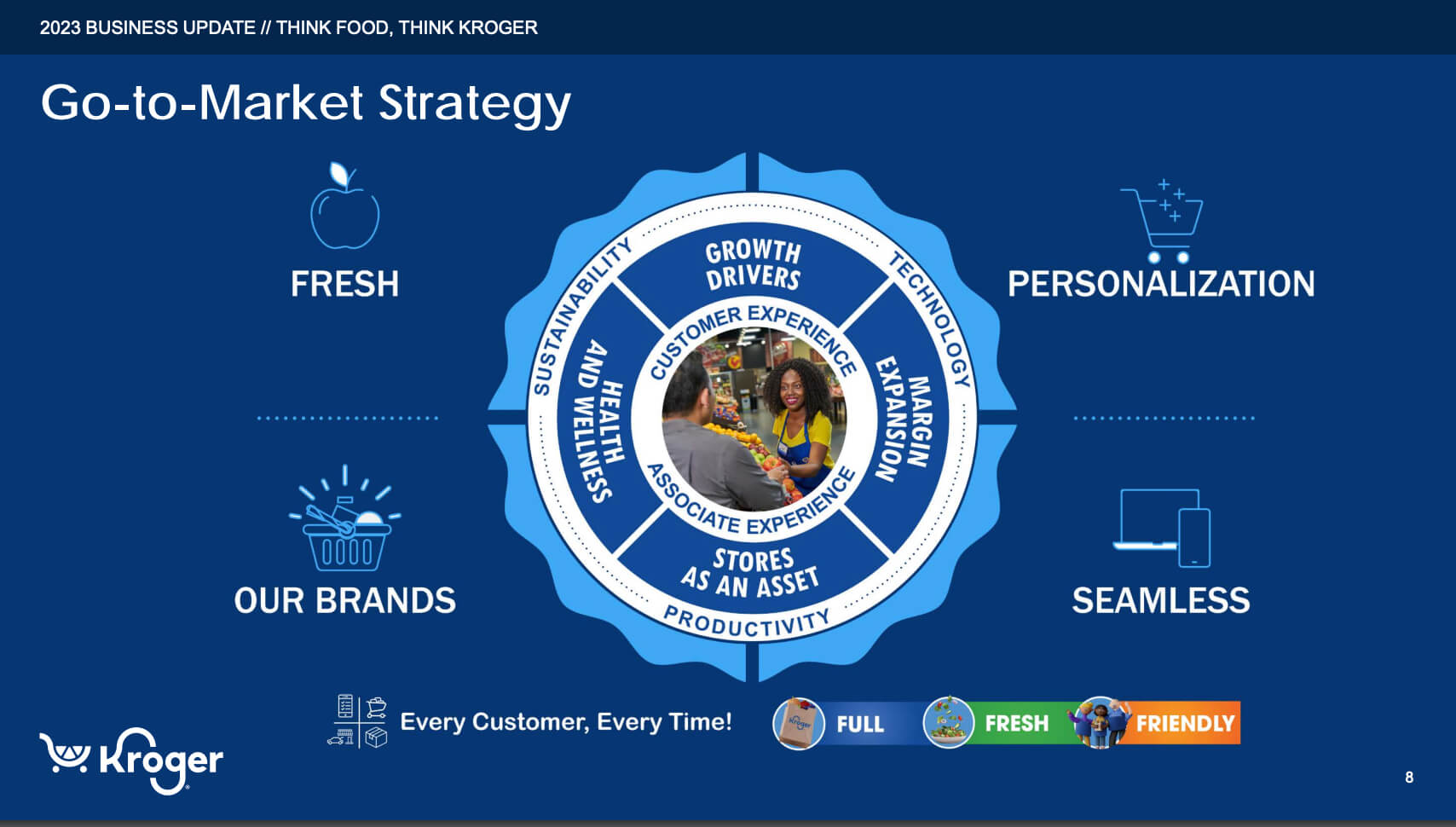
An annual report from the grocery chain Kroger demonstrates how the company focuses on customer experience by providing fresh products, house brands at different price points, and personalized coupons to enhance loyalty. Its GTM strategy includes clear messaging and identifies ways to drive growth using technology and highlighting sustainability.
Partner-Led Go-to-Market Strategy
With a partner-led GTM strategy, businesses work with resellers, distributors, technology partners, or other channel partners to drive market penetration and growth. This approach can involve developing an ecosystem of strategic business partners through mutually beneficial agreements, or it can focus on retail and distribution partnerships. The goal of a partner-led GTM strategy is to leverage partners’ existing relationships, expertise, and market presence to expand reach and accelerate sales.
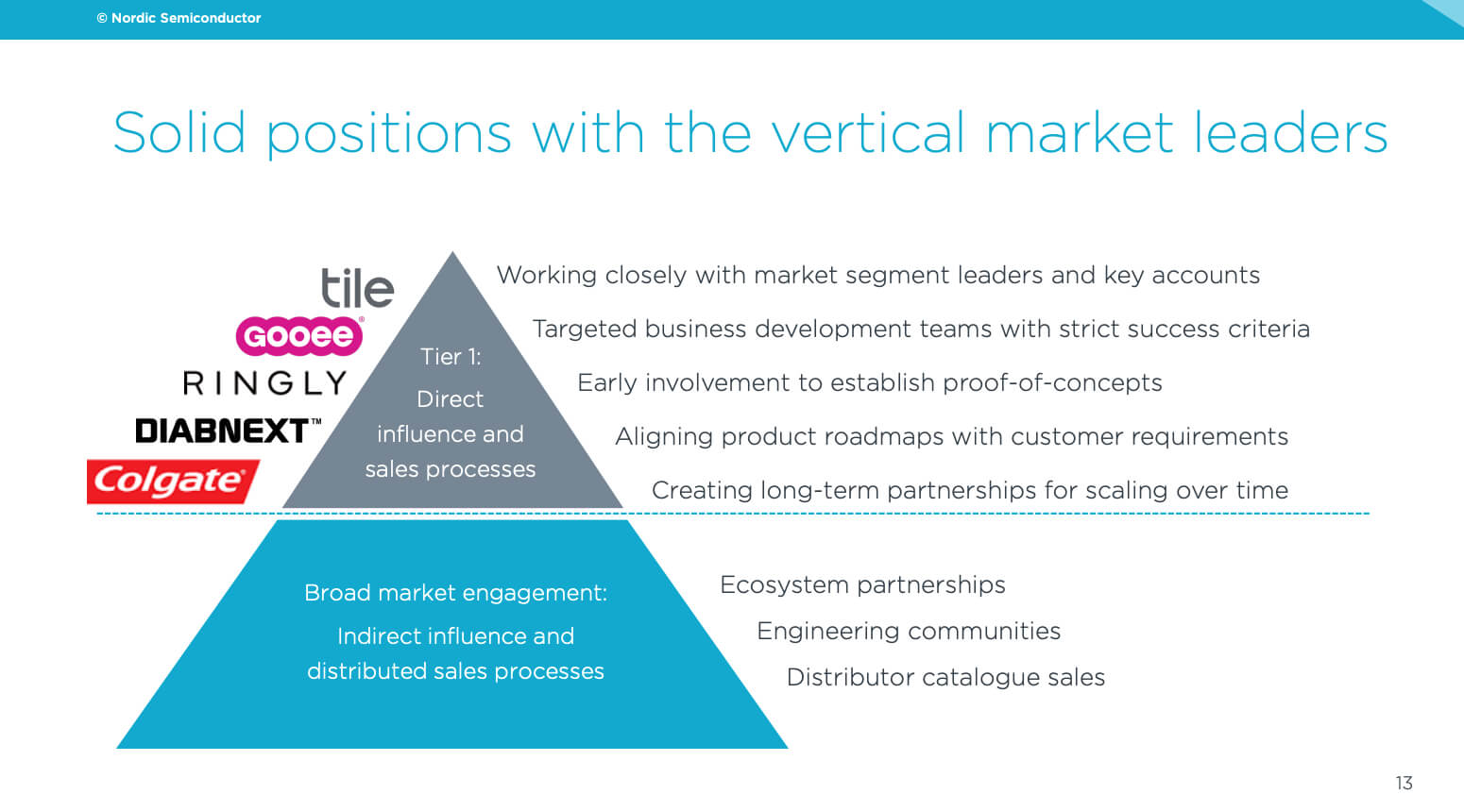
This GTM strategy report from Nordic Semiconductor shows how the company works with market segment leaders to integrate its technology into new product lines. The report highlights a partnership with Tile, a company that produces Bluetooth tracking devices. Tile integrated the Nordic product into a new range of its tracking devices, enhancing visibility and adoptions for both brands.
Nordic also leverages its partner-led GTM strategy by collaborating with broadline and value-added distributors. Broadline distributors help Nordic with global or regional distribution, fulfillment, and logistics. Value-added distributors focus on specific regions and provide design services for end customers. Finally, Nordic engages in joint seminars, workshops, and co-marketing initiatives with its key partners. By aligning product roadmaps and creating long-term partnerships, Nordic effectively scales its business and strengthens its market position.
E-Commerce Go-to-Market Strategy
E-commerce strategies focus specifically on selling products online. Most often, e-commerce brands sell direct-to-consumer (DTC), but they may also sell to online marketplaces such as Amazon or Etsy. An e-commerce GTM strategy typically involves social media campaigns, influencer marketing, and online advertising.
Beginning as an online DTC mattress company without brick-and-mortar locations, Casper is a great example of using e-commerce strategies to scale growth. The company is known for its hassle-free returns, which made it easier for customers to take a risk on an online purchase, as well as its playful advertisements and high-profile influencer partnerships. In a 2021 report, the company showcased its customer-focused GTM strategy.

While the company’s GTM strategy has evolved to include retail partners and its own store locations, the heart of the Casper brand is still in e-commerce. The customer journey can end with either online or in-store purchases, but a website visit is always a key part of the buyer’s consideration process.
Disruptive Go-to-Market Strategy
A disruptive GTM strategy is for brands that are aiming to change the landscape of their industry by offering innovative solutions that differ from existing offerings. Similar to a product-led GTM strategy, this approach relies on a strong value proposition that highlights the unique benefits and capabilities of the disruptive product. Elements of a disruptive GTM strategy include aggressive marketing campaigns to emphasize the product’s innovative features, strategic partnerships with early adopters and influencers, and targeted outreach to ideal customers.

With its simple mobile card reader and app, Square disrupted the financial services industry by enabling small businesses and individuals to accept payments easily. It developed an innovative, user-friendly hardware to compete with traditional point-of-sale (POS) systems. In a 2019 report, the company revealed its scalable GTM strategy that begins with its strong, original brand. This strategy leverages the product’s unique assets — such as its integrated end-to-end solutions encompassing hardware, software, payments, and data — which are difficult for competitors to replicate at scale.
Square leverages direct and scalable channels in its marketing strategy, which is a key component of its disruptive approach. By focusing on marketing, Square can reach a broad audience, enhancing brand awareness and driving user engagement. By challenging the status quo and addressing unmet needs in the market, Square is able to quickly gain traction and establish a new standard within the industry.
Go-to-Market Plan Examples
Using a template ensures your GTM plan covers all the important elements so you can implement it smoothly. These customizable templates, each available with sample GTM plans, focus on the most common types of GTM strategies. They range from comprehensive plans to streamlined strategic documents and can be adapted for a variety of approaches.
Microsoft Word Inbound GTM Plan Template
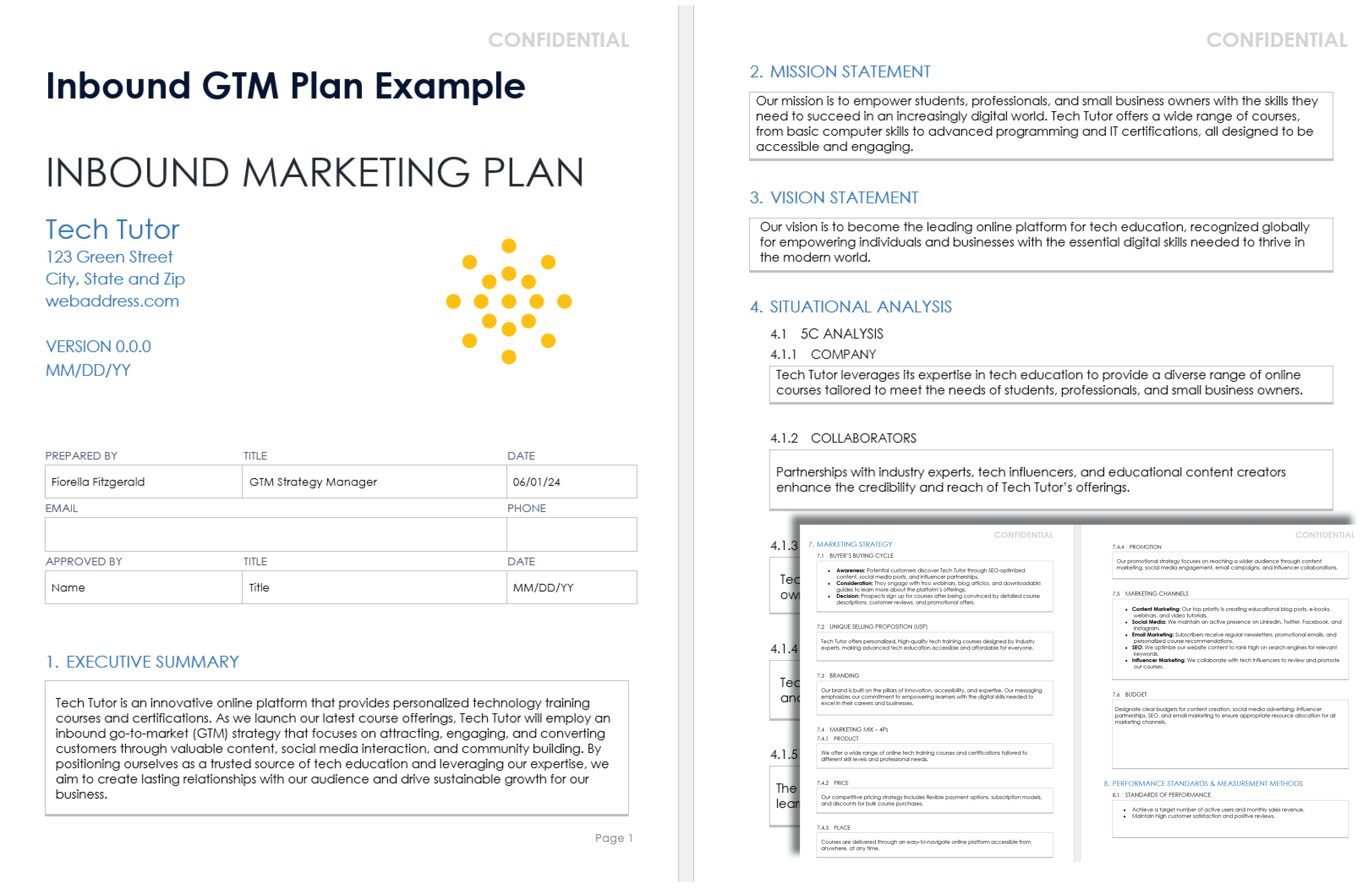
Download the Inbound GTM Plan Sample Template for Microsoft Word
Download the Blank Inbound GTM Plan Template for Microsoft Word
This comprehensive GTM marketing plan template is perfect for an inbound approach, where marketing channels and tactics are the top priority. Along with a breakdown of the 4Ps (product, price, place, promotion) of the marketing mix, it includes sections for a detailed situational analysis and information on the target audience. The sample version features an example inbound GTM strategy focusing on content marketing, social media, and SEO.
Find more helpful resources in this collection of GTM plan templates, which includes templates designed for startups, communications strategies, and SaaS.
Excel Sales Enablement GTM Plan Sample Template
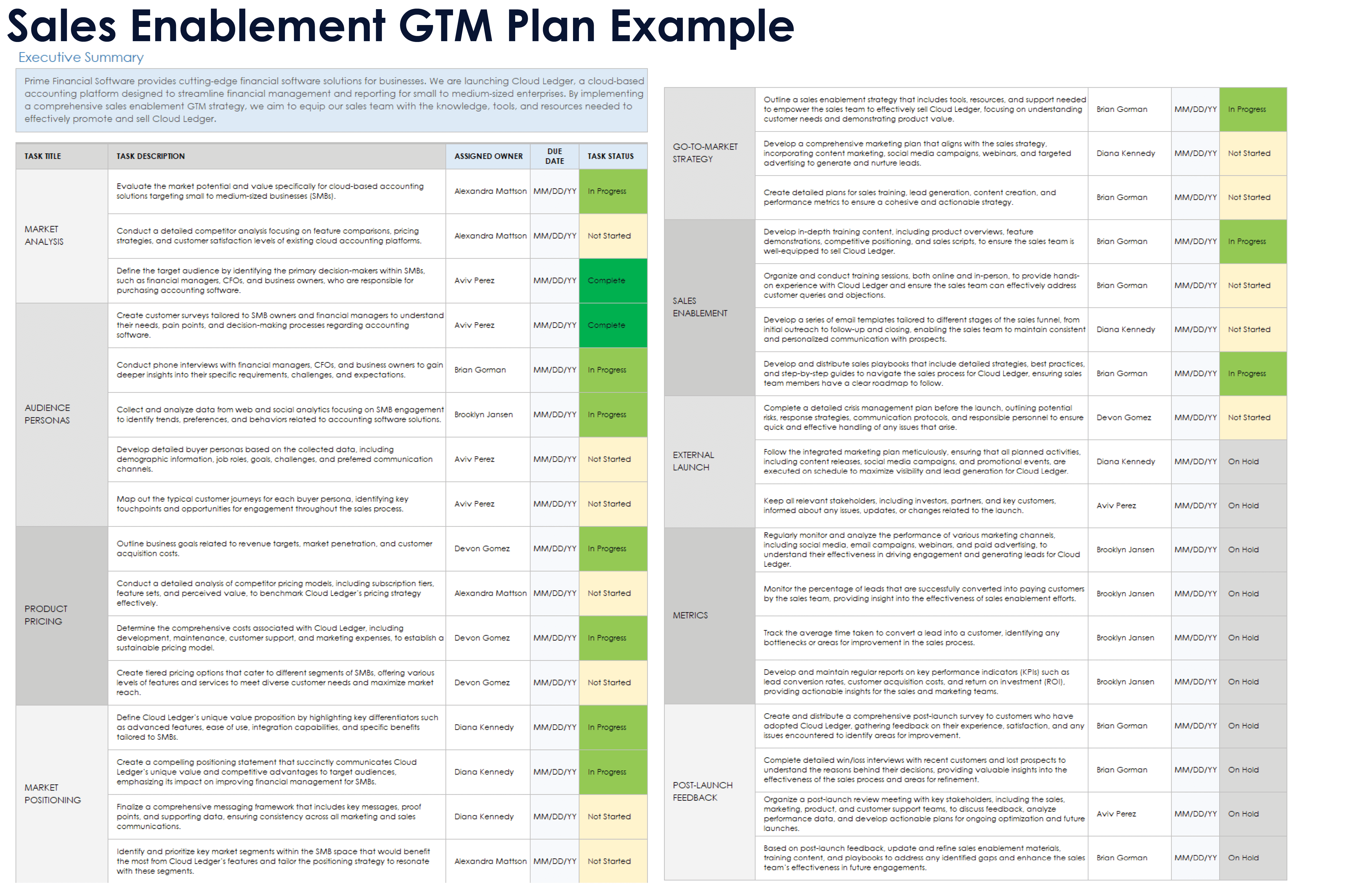
Download the Sales Enablement GTM Plan Sample Template for Excel
Download the Blank Sales Enablement GTM Plan Template for Excel
This GTM product launch plan template is tailored for a sales enablement strategy. The sample version emphasizes the importance of empowering the sales team with the necessary resources and training. This template breaks down the stages of the launch into individual tasks, such as developing audience personas and a competitive pricing strategy. The sales enablement section provides space to go into depth on the responsibilities related to the creation of training content, interactive demos, and personalized sales playbooks.
Microsoft Word Account-Based Marketing GTM Plan Sample Template
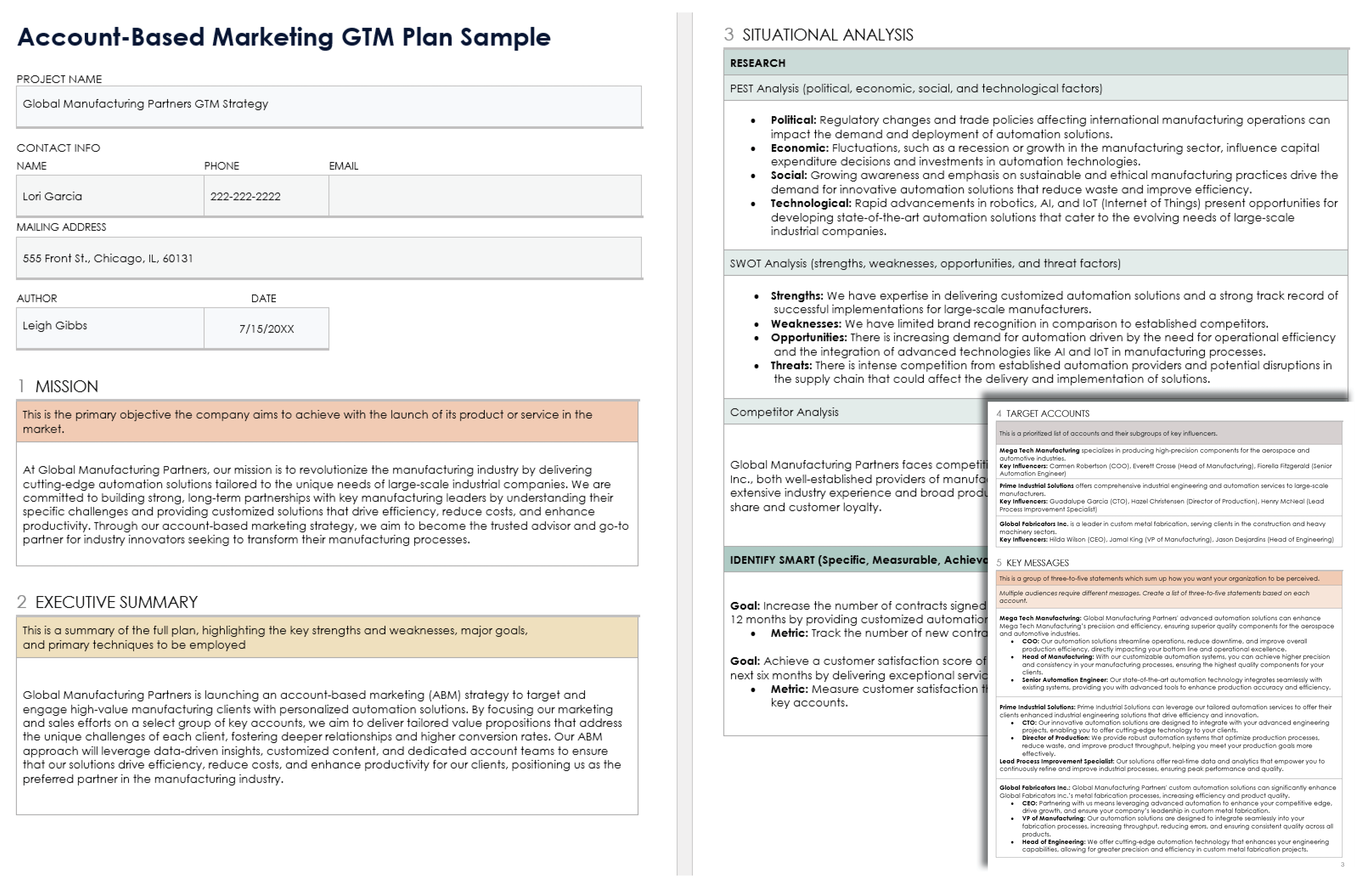
Download the Account-Based Marketing GTM Plan Sample Template for Microsoft Word
Download the Blank Account-Based Marketing GTM Plan Template for Microsoft Word
This GTM communications strategy template helps users identify key accounts and highlight subgroups of influencers in order to perfect their marketing strategy. Download the version with sample copy for a model of how to adapt your messaging to individual accounts and decision-makers. The template also includes sections for analyzing strengths, weaknesses, opportunities, and threats (SWOT), as well as for detailing specific tools, tactics, and marketing channels.
Microsoft Word Demand Generation GTM Plan Sample Template
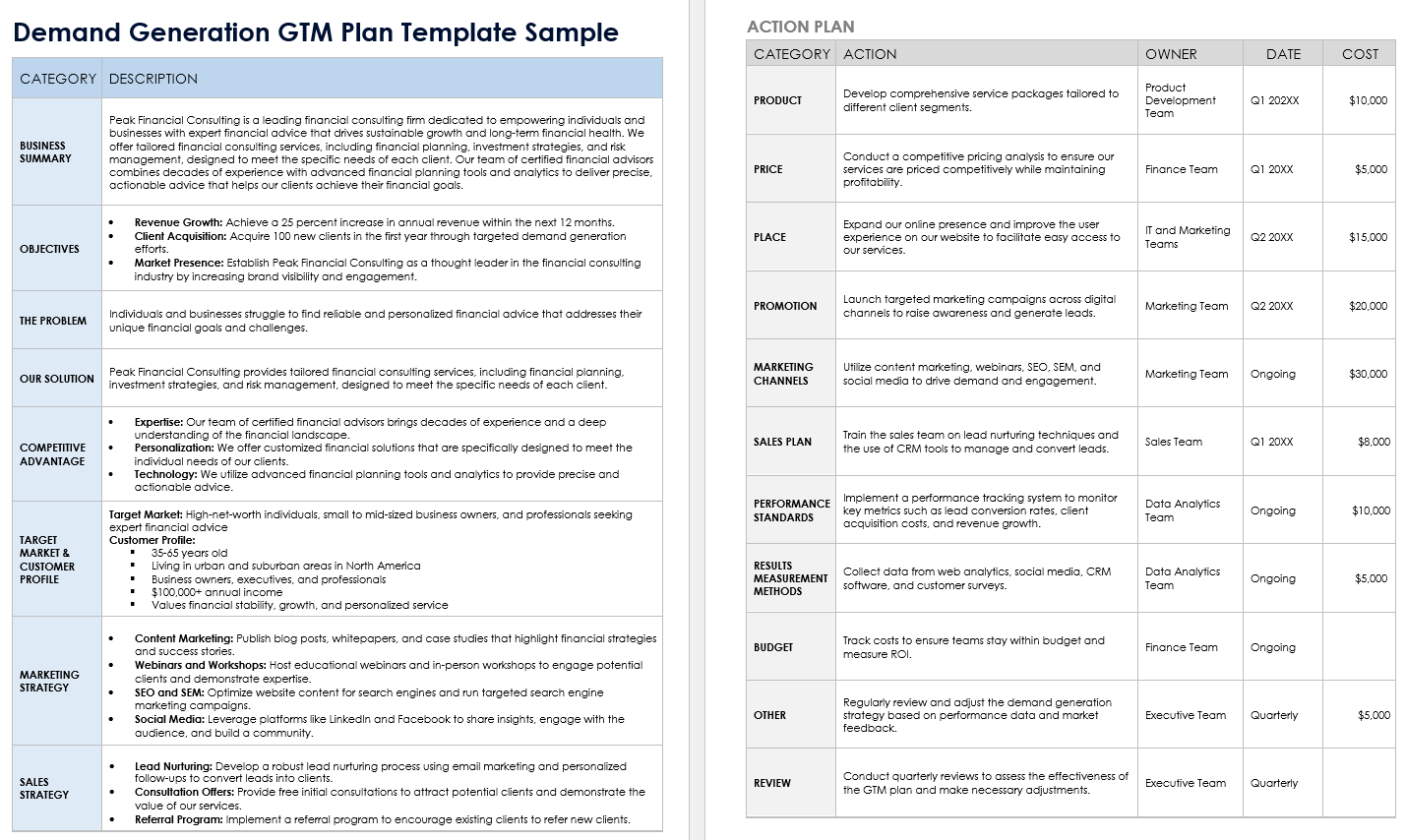
Download the Demand Generation GTM Plan Sample Template for Microsoft Word
Download the Blank Demand Generation GTM Plan Template for Microsoft Word
This streamlined GTM plan template has been adapted for a demand generation strategy. The template includes sections — such as a detailed business summary, target market and customer profiles, and a comprehensive marketing strategy — that are essential to demand generation. Additionally, it breaks down the action plan into specific tasks, such as developing service packages, conducting pricing analyses, and launching targeted campaigns. The sample version delves into demand generation tactics such as lead nurturing, consultation offers, and referral programs.
Excel Product-Led GTM Plan Sample Template
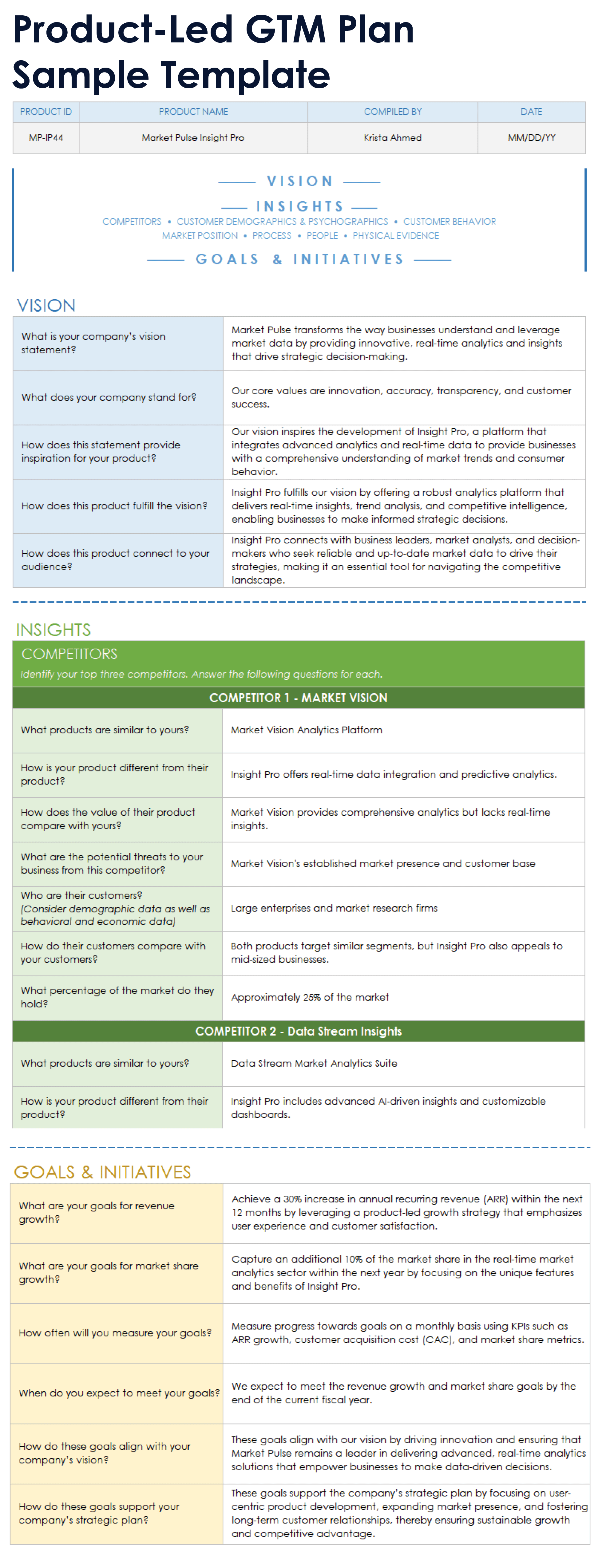
Download the Product-Led GTM Plan Sample Template for Excel
Download the Blank Product-Led GTM Plan Template for Excel
This GTM product strategy template focuses on the product as the main driver of growth and is perfect for a product-led GTM plan. It provides a structure for analyzing insights about the competitive landscape and customer behavior, as well as highlighting features of the product and problems it solves. The sample version includes a detailed analysis of multiple competitors, ensuring the product can stand out in the marketplace.
Discover additional tools in this collection of GTM strategy templates, along with tips on how to use them.
Use Smartsheet to Enter a Market with Confidence
Discover a better way to connect your people, processes, and tools with one simple, easy-to-use platform that empowers your team to get more done, faster. With Smartsheet, you can align your team on strategic initiatives, improve collaboration efforts, and automate repetitive processes, giving you the ability to make better business decisions and boost effectiveness as you scale. When you wear a lot of hats, you need a tool that empowers you to get more done in less time. Smartsheet helps you achieve that. Try free for 30 days, today.